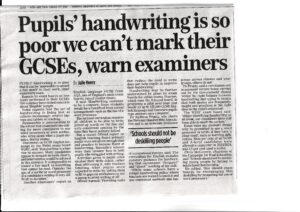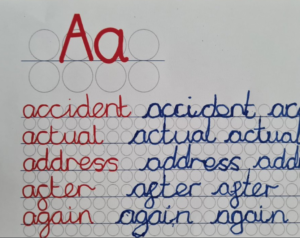I have recently come across two articles published by The Telegraph debating how and why handwriting is supposedly dying. I wanted to address a number of pertinent points and the opposite – the reasons and evidence why the skill of handwriting is essential for the development of children. This is based on decades of experience teaching thousands of students, training school teachers, both in the UK and internationally, and through the development of the Morrells Handwriting resources.
We only have to look at the lack of daily activities during lockdowns to know that this would eventually impact handwriting – not playing outside means that hands, shoulders and core strength were not improved – all crucial for handwriting and postural control.
We now face another epidemic that has been exasperated by the pandemic, poor level of handwriting in secondary schools as students progressed through the education system, moving from Key Stage 1 to Key Stage 2 during the time they were homeschooled.
I wanted to address the key points from The Telegraph articles –
Tackling the Rise of Technology
Some say the overuse of tablets and computers are the key factors in the decline in children’s handwriting, according to some experts, with the finger being pointed at the COVID pandemic.
Yes, these were factors, but the causes were there long before lockdown. We must turn to research to find the true root cause. You only have to look at how we hold objects in our hands – we just don’t use the pincer grip (using thumb and index finger together) anymore.
Unlike writing on a keyboard, the movement of the fingers to form handwritten letters promotes brain connectivity. In an era where technological advancements are reshaping education, handwriting must still form part of the curriculum (Van der Weel & Van der Meer 2024).
Dr Mellissa Prunty, chair of the National Handwriting Association is quoted – “Handwriting should be at least revised at the beginning of secondary school given that the volume of writing increases, but typing must be taught too.” I agree! I believe that touch typing should be taught in primary school, not as an alternative to handwriting but in addition to handwriting. That way, if they require a devise for exam work in Year 11, they already have the skill of touch typing.
A study (Mueller & Oppenheimer, 2014) states that writing notes by hand allowed participants to retain information better than those who typed on a laptop, even if they wrote fewer words overall. When students take notes by hand, it develops a stronger conceptual understanding than by typing. Since handwriting is slower and more tedious, it makes it harder to take notes verbatim. Therefore, students have to actually process the information and summarise it in a way that makes sense for them.
Introduce Handwriting to Secondary School Curriculum
From my perspective, I 100% agree that handwriting should be taught in the secondary school curriculum for many reasons, including the prevention of a painful pen grasp and improving legibility and writing speed.
Many secondary schools are left with the legacy of ‘cursive from the start’ which was taught before a child was developmentally ready. The current curriculum does not allow time for handwriting lessons despite it being necessary for legibility.
This is why I train more secondary school teachers on how to unpick handwriting difficulties than I do primary school teachers.
In a recent article in the Daily Mail, Julie Henry reports on poor handwriting and the effect on GCSE grades. The article concludes that we should not be deskilling our children by promoting the use of devices for exams.
Handwriting must be taught in secondary schools.

Making a Handwriting Curriculum Fit For Purpose
“Today’s national curriculum expects all children to be able to write joined-up words on the line and with consistent spacing by the time they leave primary school, but does not specify how handwriting should be taught.”
The current curriculum is heavily weighted on handwriting. However, there has previously been a disappointing absence of direction on how to teach handwriting.
Unlike other countries, the UK does not recommend any particular font or style for handwriting, allowing schools the freedom to choose how they teach handwriting. This has led to confusion and poor teaching.
The current curriculum states that handwriting should be taught correctly. However, from working with over 6000 schools, it is glaringly obvious that schools are unaware of what ‘correctly’ means.
Handwriting is not on the ITT so teachers are reliant on their placement school to show them how to teach handwriting ‘correctly’, and ‘discreetly’, including how to sit and hold a pencil correctly. Many of those placement schools are teaching handwriting incorrectly.
As a result of not specifying what ‘correctly’ looks like, the trend of the entry/lead-in stroke, nicknamed cursive, swept through schools. Lack of knowledge on how this would affect visual processing, and poor guidance from the previous government resulted in children being forced to write in an overly cursive script before they were developmentally ready to do so.
The lack of expertise on how to teach children’s handwriting correctly has previously resulted in reception children being taught to join up their letters before they were developmentally ready.
Worrying new handwriting trends result in poor handwriting

During recent school training visits, I have seen for myself that schools have been teaching children Bubble Writing as an intervention, citing claims that it has a quick success rate for teaching handwriting. This style has no evidence based research and just like the cursive with the entry/lead-in stroke, it has only been introduced for commercial gain.
I first highlighted the danger of this worrying handwriting style to both Ministers and the Department for Education in my reports to them dated November 2022 and March 2024.
In years to come, we will be discussing the cognitive damage that this handwriting style caused and examining why such a style was taught in our schools. I will continue to highlight how these trends only paper over the cracks in primary education which reopen in secondary schools, damaging legibility for exams.
So, we only have to look at these trends of teaching poor quality handwriting styles to know what is driving down the standard of handwriting in our schools.
Handwriting is a cognitive skill. The emphasis MUST be on good cognitive development in the primary years to ensure all children are able to write legibly in secondary school exams.
If you would like to learn more about the cognitive development needed to ensure legible handwriting, contact us to discuss how Morrells Handwriting can support you.


